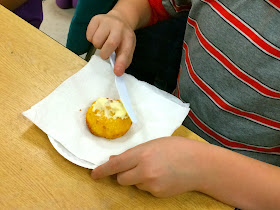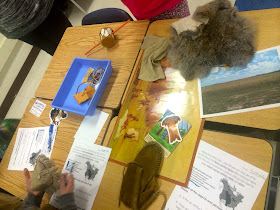We are just wrapping up one of my favorite units - Native American Indians. During each unit, our room reflects our unit and student learning.
In READING, we have been using Native American Legends during our "Story Element" unit as we study Character, Setting, Conflict, Resolution, and events that help create the plot and build toward the Climax.
After studying, how characters change throughout a story, we discovered that many Native American Indians had multiple names based off their actions throughout their lives. We then created our own Native American Names and symbols.
The Northwest American Indian tribes created totem poles to share their family heritage and to tell their stories. Using creative WRITING, along with our READING lesson on "Character Traits," we created short paragraphs that described each of our family members on our totem poles. We assigned an animal to each member of our families according to the character traits applied to what the Natives applied to that animal.
As with each unit, students are required to read at least one NON-FICTION text on our social studies unit. They fill out a sheet highlighting the who, what, when, where, why, how as well as find one FUN FACT to add to our Wall of Facts for the unit. They are also encouraged to test on the
book to get a running record of non-fiction comprehension and practice.
In WRITING, we have been working on creating strong expository (informational) paragraphs. After creating dream catchers with our grandparents, we went on to research them more and write about them.
In both SCIENCE and SOCIAL STUDIES the kids are researching how plants, animals, and Native American groups ADAPTED to their environments.
In MATH, students worked with fractions to create "maize" or corn {bread} which was a dietary staple for many Native American groups. It is one of the newly discovered products from the New World, brought back to Europe, Africa, and Asia by early explorers.
For our Thanksgiving Celebration, we enjoyed eating our corn bread muffins, created by the students during math class using fractions. We also made homemade butter using an old fashioned technique of "Churning" much like the Europeans would have used during the time of early exploration. Dairy Animals, such as goats and cows, were old world products brought to the Americans by explorers.
Do any of you teach thematically?















































